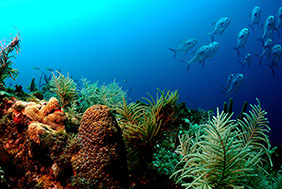Featured Archive - 2009 Publications
Below is a sampling of publications generated by NOAA's coral ecosystem activities in 2009. To access a complete list of NOAA coral ecosystem related publications, use the CoRIS Geoportal
(https://www.coris.noaa.gov/search/) search tool.
The workshop involved presentations on the biology, taxonomy, and status of populations; fisheries; existing management approaches; trade and other threats; uses of Corallium and major markets; possible conservation measures including a CITES listing; and detailed country reports. This information, plus the working group tasks and reports, are included here in the Proceedings of the First International Workshop on Corallium Science, Management, and Trade.
The NOAA Coral Reef Conservation Program (CRCP) conducted two regional workshops in Hawaii (2008) and Puerto Rico (2009) to address its Coral Reef Ecosystem Integrated Observing System (CREIOS). NOAA scientists with technical expertise in mapping and monitoring coral reef ecosystems met with resource managers and local scientists from all U.S. coral reef jurisdictions, as well as representatives from Federal agencies and Fishery Management Councils.
Recognizing the need for a strategic plan of action to combat a health crisis for Pacific Reefs, the Coral Disease and Health Consortium (CDHC) convened a workshop to help organize and coordinate a scientific effort focused specifically on coral health issues in the Pacific. The goal was to develop an action plan that would enable regional scientific efforts to detect, identify, characterize, and manage coral diseases in the Pacific.
NOAA’s Coral Reef Conservation Program (CRCP) partnered with the
National MPA Center to obtain accurate digital boundaries for MPA sites
in the five U.S. Coral Territories, Hawaii, and Florida from the Dry
Tortugas to Biscayne Bay. This analysis is part of an ongoing effort by
the U.S. Coral Reef Task Force (USCRTF) to evaluate protection levels of
coral reefs within Marine Protected Areas (MPAs) and quantify the area
of U.S. coral reef ecosystems protected in no-take reserves. It built
upon information from the National MPA Center's Inventory of Marine
Managed Areas (MMAs) and demonstrated that the percentage of coral reef
ecosystem resources in MPAs and no-take MPAs varies dramatically by
location.


